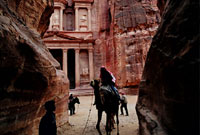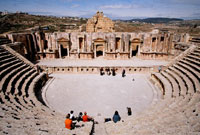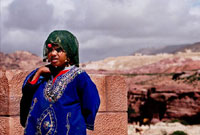|
Come and See the Natural Beauty of Jordan's "Lost City"
by
Amanda
Castleman
Hooves
tattoo down the Siq, a sinuous half-mile stretch of canyon.
Dusk drips down the walls. Gods squat in the shadows. Ancient
desert lords hacked into the scarlet sandstone. We cower to them, alone
and forsaken.
 |
|
A man on as horse at Petra.
|
Tak-a-TAK,
tak-a-TAK, TAKKA, TAKKA, TAKKA-tak. Like typewriter keys, punched
hard in desperation, the hoof claps echo, cascade, and consume
all other sound. My life shrinks to this simple truth: nightfall
in a narrow rift. I am cornered in an alien and unfathomable
land. The beats signal danger. Takka-TAK.
The
rider charges past, leather coat tails aflap, silk neck scarf
tonguing the breeze. His hands grip the reins. His feet plant
solidly on the horse's saddle. "Oh my God," my friend
murmurs, clutching my dusty arm, "That's Indiana Jones!"
This
comment is high comedy, so near the grand cliff-shrine that
Harrison Ford theatrically toppled in The Last Crusade. We collapse
in giggles, two American women in the Middle East. Here despite
the nearby war. Despite the "honor" killings. Despite
the headscarves that we can't ever condone, however culturally
conscious or politically correct we grow.
Much
about this nation eludes us, and so it should. The Hashemite
Kingdom of Jordan is just 57 years old, but its history trails
back to the Bible — and beyond. This country boasts Lot's salty
spouse, the baptism pool of Christ and the mountain where Moses
first glimpsed the Promised Land. The first Islamic dynasty,
the Umayyads, built palaces beside the bayt shar, the goat-hair-tent
homes of their nomadic cousins.
 |
|
Traditional
bagpipers perform in the restored Roman amphitheater at
Jarash
|
But
Petra, the country's archaeological diva, is an easy study.
The terrain — great swirls, lumps and crags of sunset-hued stone,
slicked by wind and water - has the piquant beauty of the Grand
Canyon. The Siq (pronounced "seek") snakes through
a half-mile massif that towers 250 feet high. Its mouth kisses
the Pharaoh's Treasury, the Khaznat Far'oun, a glorious confusion
of East and West, deservedly one of the world's most famous
facades.
The ancient Arabs etched buildings into the chasm beyond. Greco-Romanesque columns chipped out here, a Christian monastery there, tombs everywhere. This oasis once housed 30,000 people, though only six inches of rain fell each year. They grew rich, catering to the spice and silk caravans crossing the vast, kitty litter-like grit of the Syrian Desert.
Petra is intoxicating: art and natural beauty wrought wide-screen…with all the spiritual wallop of Sedona or Stonehenge. But its genius is in the Bedouin. The Bdul still swarm over their ancestral home. They peddle camel rides and coffee laced with cardamom. They shout and sing and sell trinkets under embroidered canopies.
Cook fires blacken crannies in the rock. Goats graze in the scrubby slopes, studded with cacti and cedar trees. Footsteps crush eggshell-shards of Nabataean pottery, fired over 2,300 years ago during the Semitic empire's heyday.
 |
UNESCO evicted the Bdul from Petra in 1985. They work at the site now, , but sleep in a nearby village. |
The women inscribe inky kohl around their eyes, dipping silver toothpicks into camel-bone compacts. The men knot their turbans - the red-checked Jordanian kaffiyeh -tight against the gorge's gusts. Children race donkeys up and down the snaggle-toothed scarlet amphitheater.
"They are the preservers of knowledge, of birds, of animals, of flash floods," points out Patricia Bikai, an American archaeologist who studies Petra. "They grew up in tents there. They know more about my excavation than I do."
UNESCO evicted these Bedouin in 1985, when it designated the park as a world heritage site. No more children would be born in Nabataean tombs under the gaze of the goddess Hayyan.
Squeezed into Umm Seyhoun, a modern village, they resent the concrete cubicles. Home by day, displaced by night, the Bdul time-share their past. Discarded mattresses and snarls of blankets show that many sneak back to sleep. Petra sprawls over 400 square acres, so disappearing is as easy as stepping in camel dung.
In fact, the city itself was lost once. Earthquakes destroyed the desert stronghold in 393. Sand smothered its bones. By the 13th century, only the Bedouin remembered these caves and their poetic depths. A Swiss explorer, Jean Louis Burckhardt, wandered here in 1812, unearthing the "rose-red city half as old as time," as the theologian John William Burgon famously dubbed it.
An Arab proverb stresses: "for every glance behind us, we have to look twice to the future." Petra's future involves a $5.6 million Swan-style visitors' center makeover in 2006. Pine and olive seedlings will sprout into shady groves, binding the sifting desert soil. Its guardians will recycle wastewater, thanks to a $27m scheme, aided by the World Bank. Limited access, for tourists and Bedouin alike, will preserve Petra's marvels, but at a price. This site, so vital, may slip into a dusky half-life.
Jordan has many other delights: the briny Dead Sea and its salt encrustations, Crusader forts, the indigo Gulf of Aqaba, and the city of Madaba's elaborate mosaics. See the slender oryx, white Arabian antelopes, that have been rescued from extinction, tribal pipes wailing in the Roman amphitheater at Jarash, and backgammon battles in cafes and great spice sacks in Amman's outdoor market, the suq. See the moonscape of Wadi Rum, which T.E. Lawrence dubbed "vast, echoing and God-like".
One scene frames the Hashemite Kingdom: a moment in the Siq, poised between stone and sky, dark and light, awe and laughter.
The ruins are dead. Long live the ruins.
If You Go...
Petra
Jordan Tourism Board
P.O. Box 830688
Amman, Jordan 11183
Phone : + 962 6 5678444
e-mail
|